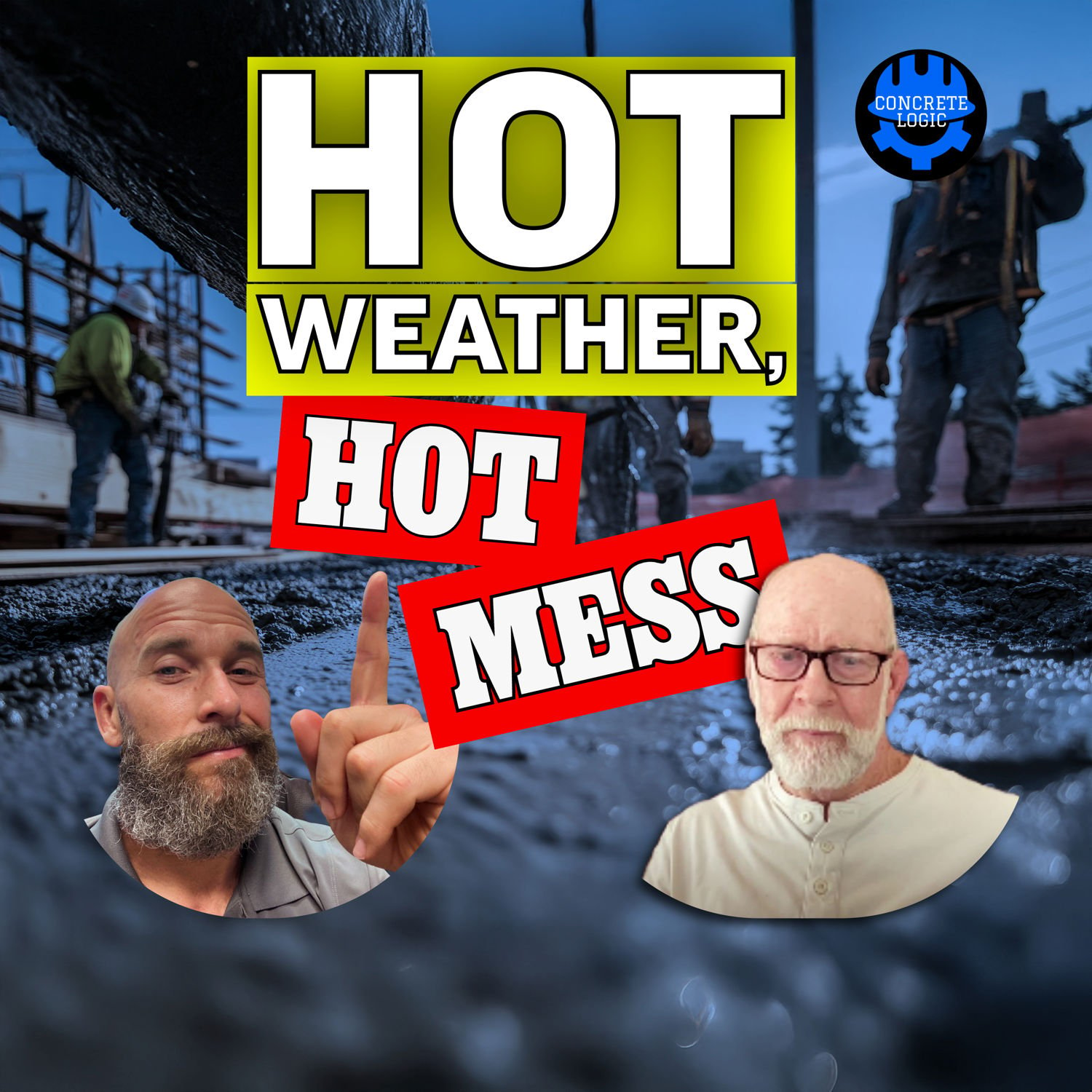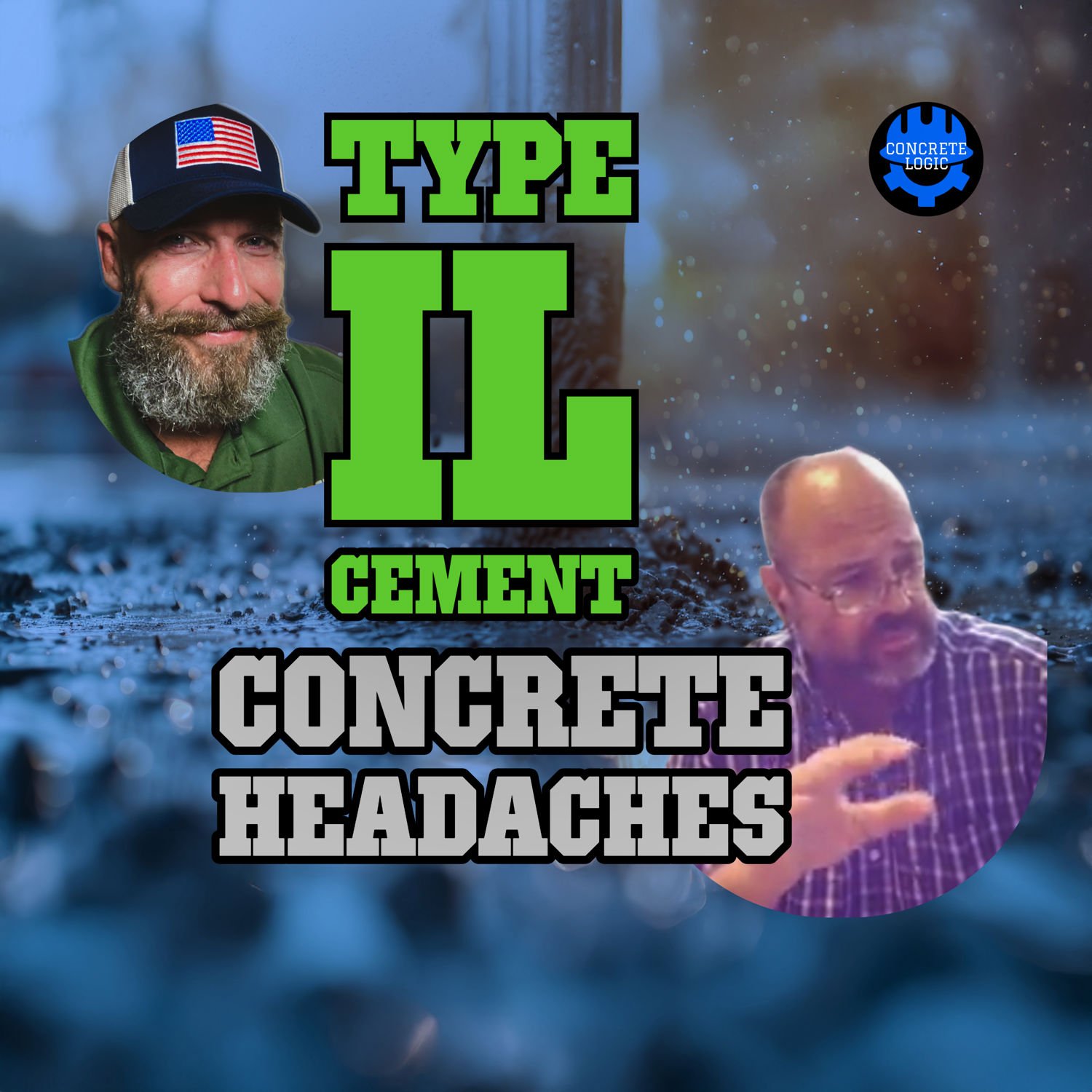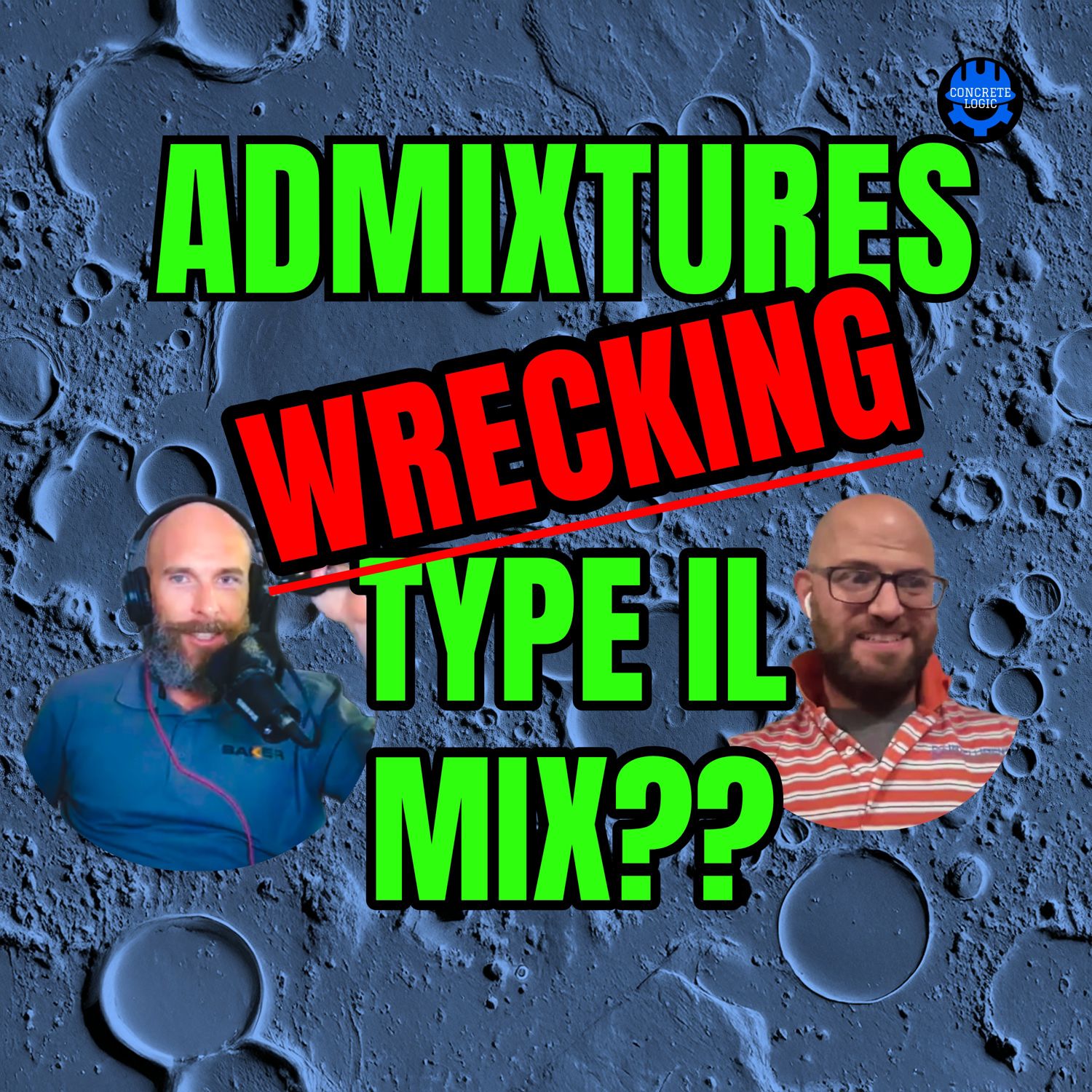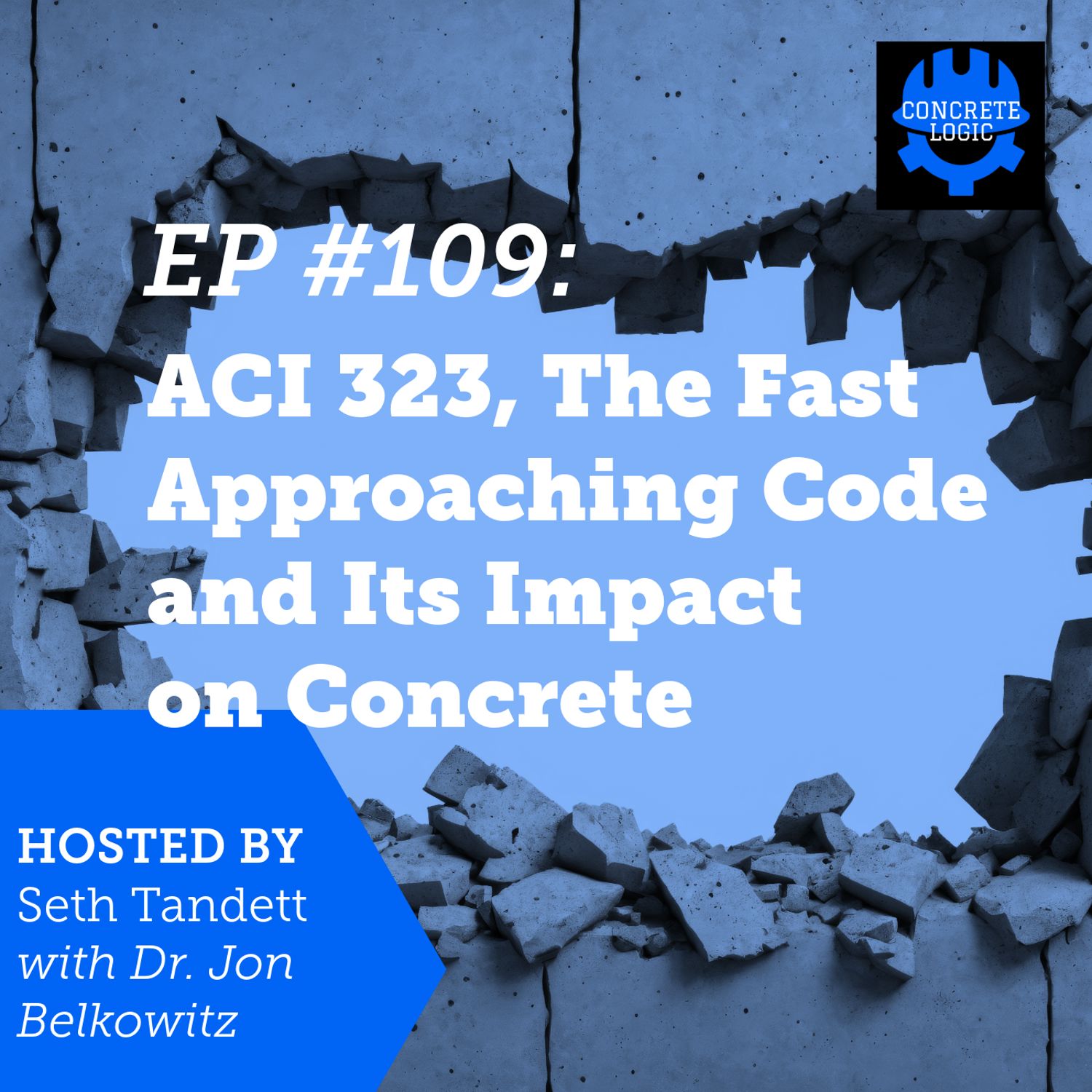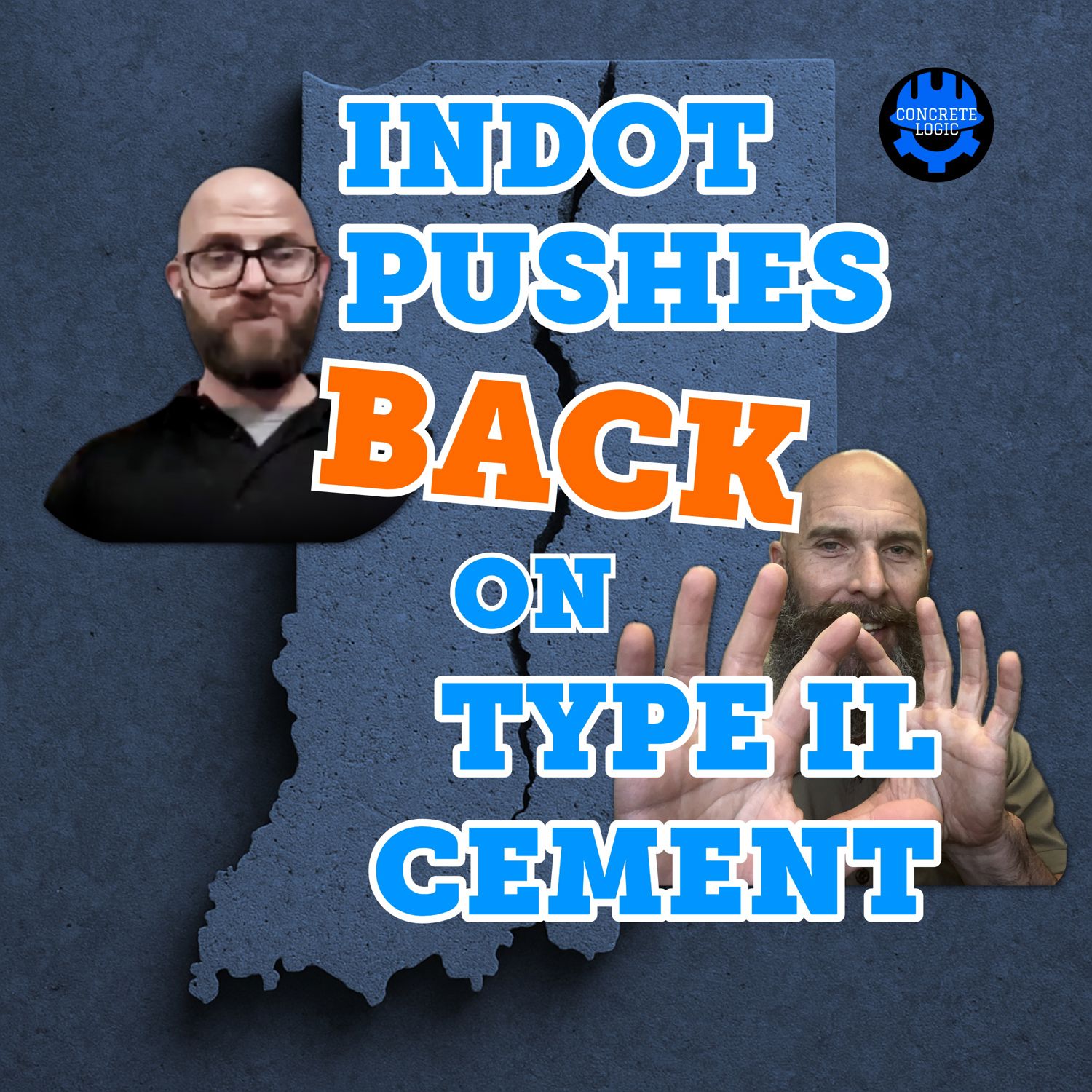EP #131: AI in Concrete Construction: Threat or Opportunity?
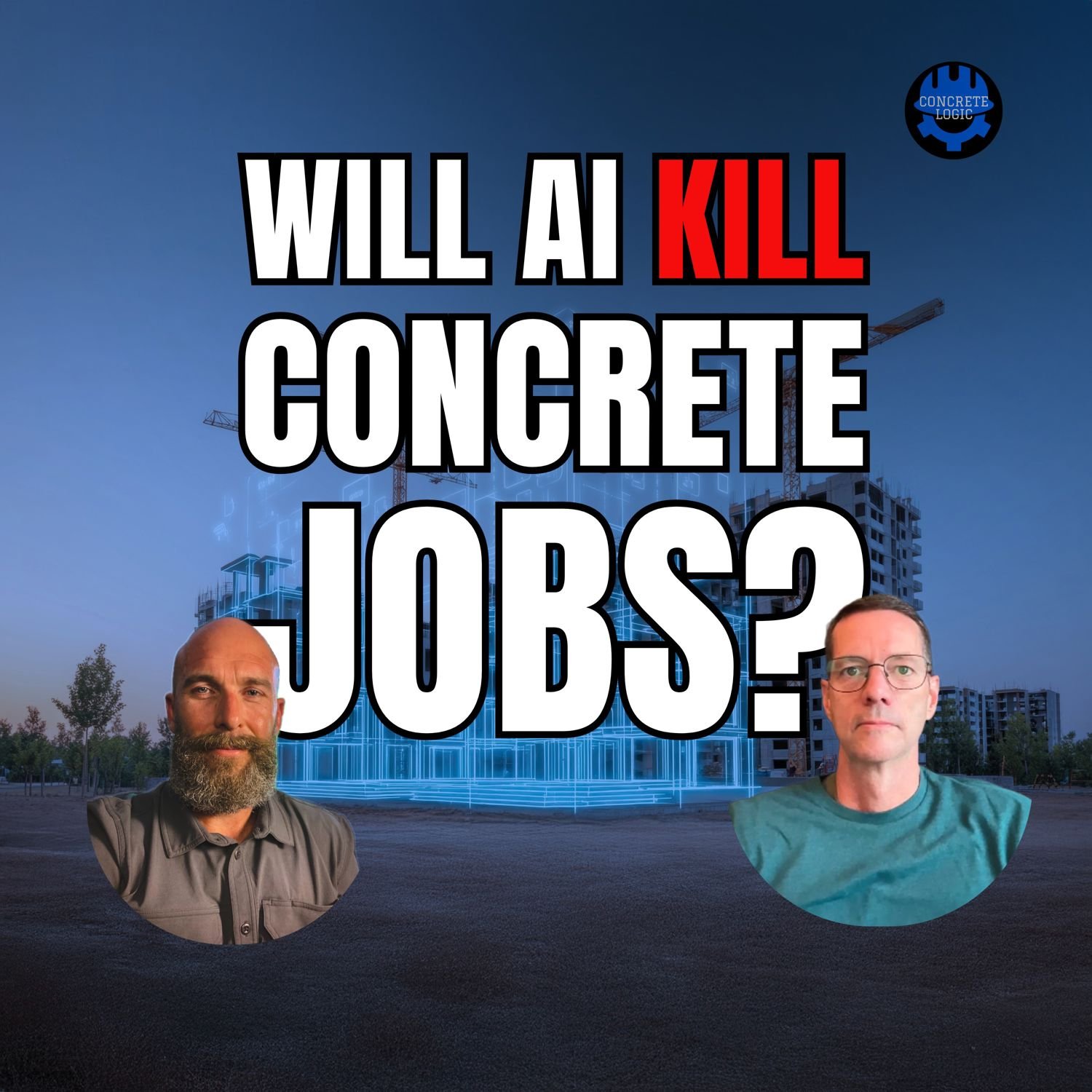
Is Artificial Intelligence coming for your job in concrete?
That’s the big question in this episode of the Concrete Logic Podcast. Seth sits down with Chad Gill, President of VAs for Construction, to unpack how AI is already reshaping the industry. From jobsite communication and safety talks to project management and career paths, this episode tackles the uncomfortable truth: AI isn’t just a tool—it’s a disruptor. The opportunities are real, but so are the threats. If you’re in concrete and construction, you can’t afford to ignore what’s coming.
What You’ll Learn
- What exactly is AI and a large language model (and why should concrete pros care)?
- How can field leaders use AI to turn jobsite chaos into clear, professional communication?
- What practical AI tools exist today for handling manuals, SDS sheets, specs, and safety talks?
- Why are “gray collar” trades positioned uniquely in the AI shift?
- How will AI impact the traditional career ladder for project engineers and assistant PMs?
- Is AI really taking jobs—or just changing how we use people on jobsites?
- How can companies re-skill and re-align their workforce to get ahead of this shift?
Chapters
00:00 – Welcome and intro to Chad Gill
01:00 – AI in construction: hype vs reality
02:15 – Defining AI and large language models
07:00 – Why AI adoption feels like a “tectonic shift”
09:05 – Concrete industry use cases for AI
11:00 – AI for manuals, specs, and safety talks
14:00 – The importance of good prompts (“prompt jockeys”)
17:30 – Voice-to-text and better field reporting
20:00 – AI for project management and estimating
22:00 – Avoiding hallucinations and bad data
25:00 – Coaching, feedback, and leadership with AI
27:00 – Pre-pour meetings and training applications
29:00 – Will project engineer jobs disappear?
33:00 – Realigning roles for efficiency and safety
35:00 – Final thoughts and how to connect with Chad
Guest Info
Chad Gill – President, VAs for Construction
Website: https://vas4construction.com
LinkedIn: https://www.linkedin.com/in/chad-gill
Concrete Logic Academy
Want to go further? Visit Concrete Logic Academy for free and premium courses built for industry pros: https://www.concretelogicacademy.com
Support the Podcast
If you value conversations like this, please consider supporting the show:
- Donate: https://www.concretelogicpodcast.com/donate
- Sponsor opportunities are available for consultants and businesses looking to connect with the industry’s most engaged audience.
Credits
Produced by Jodi Tandett & Concrete Logic Media
Music by Mike Dunton (Instagram: https://www.instagram.com/mikedunton)
Stay Connected
Host: Seth Tandett, Concrete Visionary & Industry Expert
LinkedIn: https://www.linkedin.com/in/seth-tandett
YouTube: https://www.youtube.com/@concretelogicpodcast
00:00 - – Welcome and intro to Chad Gill
01:00 - – AI in construction: hype vs reality
02:15 - – Defining AI and large language models
07:00 - – Why AI adoption feels like a “tectonic shift”
09:05 - – Concrete industry use cases for AI
11:00 - – AI for manuals, specs, and safety talks
14:00 - – The importance of good prompts “prompt jockeys”
17:30 - – Voice-to-text and better field reporting
20:00 - – AI for project management and estimating
22:00 - – Avoiding hallucinations and bad data
25:00 - – Coaching, feedback, and leadership with AI
27:00 - – Pre-pour meetings and training applications
29:00 - – Will project engineer jobs disappear?
33:00 - – Realigning roles for efficiency and safety
35:00 - – Final thoughts and how to connect with Chad Guest Info Chad Gill – President, VAs for…
Seth Tandett (00:00)
And welcome to another episode of the Concrete Logic Podcast. Today I have Chad Gill. He's president with VAs for construction. And today we're going to talk about AI as far as in construction. And we're going to talk a little bit about the blue collar. I like gray collar, Chad, gray collar. ⁓
Chad Gill (00:20)
Drink, Harald.
Seth Tandett (00:24)
how great color, blue collar trades can use AI. We're also going to talk about maybe some quote unquote threats of AI in our industry. Chad, do you want to tell folks more about yourself before we get started?
Chad Gill (00:38)
Yeah. So Chad Gill, I was president and owner of Concrete. We were a concrete grinding and polishing company doing commercial work all up and down the East coast. did that for 23 years. know, background, I came out of VMI with an engineering degree, found myself starting a company, working in the trades. I love construction. I love the people. I love everything about it. And so it was a great way to kind of just...
It's a very fulfilling job. know, at the end of a construction day, you can look back and see what you did. that's, I don't think people in other jobs don't get that, know, exited that company. And then once I did that, you know, we started using virtual assistants inside of that company and saw the advantages from it. And then that spawned us to start another company and that's the VA's for construction. then through that got really interested and passionate about AI and
what it can do and what it will do for our industry and our trades and stuff like that. I think this is a good time to be in it, but it's definitely gonna have some impact. So yeah, thanks for having me on, man. Super excited about it.
Seth Tandett (01:47)
Yeah, I think since you, you know, just to clarify your virtual assistants, we will make sure people know that you use real people for that. So we're not going to say that we use AI for virtual assistants yet. And maybe we'll dabble into that later in the conversation. But I think just to start off with, can we talk about what AI is and kind of define what AI is? think that's kind of lost on people. And then
Chad Gill (01:56)
Yeah.
Seth Tandett (02:13)
if you know anything about large language models as well, if you could define that. ⁓ Those two things before we get started.
Chad Gill (02:19)
Yeah,
for sure. So AI has kind of become this catch-all throwaway term, kind of like COVID. Nobody really knows what it is. It's just something. But most of what people think of for AI is really automation. So if you've used Google Maps to get you somewhere, that's AI. If you get your Netflix recommendations and stuff like that, that's
That's automation, that's AI, looking at different aspects of what you do and trying to predict your next behavior or what you would like for that answer to be. Generative AI is what you hear talking about, things like chat GPT or if you're in Google using Gemini. It started out as a chat box. People use it as a Google search on steroids, but it's much more than that.
It's a, if in fact, if you can get shifted where you think of AI as a thought partner, then you really kind of escalate what you can do with AI. But all AI is a large language model is where one of these big labs like open AI or meta or Google, and there's about five ones that are, that are really big. They take all the information and data that they can find. mean, huge volumes.
huge amount, like almost all known human knowledge that they can get at that moment in time. And then they feed that into a mathematical model. And that's called the large language model. It's so big that when they're training it, which means they're running it through their algorithm to create this mathematical model, like I think when they were training GPT-3, a version of OpenAI that's now probably considered
old because it came out in February or something. It's like, that's the speed of change here. It took enough power, it took so much power to train it to process all that data that you could run San Francisco for something like three days. Now San Francisco is very poorly run, but it still uses a lot of power. So it's a huge usage of power, right? But it processes, and all it does, what the large language model does, it's not a...
Seth Tandett (04:15)
Wow.
Ha ha ha ha ha
Chad Gill (04:30)
It's not a sentient being. It's not God in a box. All it's doing is it's taking and saying of all the trillions of conversations and videos and stuff that the model has seen and had uploaded into it, based on that and the last and these sentences that you typed into the chat box, it's predicting and guessing what you want the next word to be or the next series of words. That's how it thinks.
if you want to call it thinking. And that's what it does. And so these models get bigger and bigger and more efficient. then the reaction you see makes it seem like the tool that you're using, the AI, is getting smarter and smarter. And they absolutely are. So it looks like it thinks. It has human-like responses and all those kinds of things. But it's not a human.
And it's driven by some rules that are put in by the people that run these labs. So that's where you see things like one version came out and it was like too sycophantic, you know, it wanted to just make everybody happy. So told you everything you said was a good idea. It just told you it was a great idea. you're like, you know, some people like that, you know, but that's probably not a good idea. so that's what these models are. And then people always ask, what's the best one to use?
It really doesn't matter. It'd be like if you were going to a family reunion and you were going to have to do a foot race against all of your cousins and you don't want to lose. And then somebody taps you in the shoulder and says, Hey, you can pick anybody from the Olympics sprinting team to run for you. Like it doesn't matter who you pick. They're all faster than your cousins. So these things are, these things are amazing. It's Chad GPT is the one that most people by far use because it's the most common one. And then there's some things like
Seth Tandett (06:04)
you
Chad Gill (06:13)
People talk about the paid version versus the free version. What you need to know is that if you put anything in the free version, that's data they automatically include and use when they're training their next model. somebody, and if you have a paid version, you get some security built into that because they tell you they're not gonna use it. So I don't know how you would know, but they promise. there's some security with having paid versions.
and that kind of thing. But yeah, that's a really good, I mean, that's kind of the quick and dirty of the language model in the AI.
Seth Tandett (06:44)
you
Yeah, that was perfect. Thank you. Yeah, and it's not, people think this is like a new concept. just think it's, would you say it's, I heard someone say this, I'm taking this from someone, I didn't come up with it, but I'm gonna show my age as well. Do you remember Clippy on Microsoft, a word, the little clip guy that used to pop up when you're typing a paper or whatever, and he was your little helper?
Chad Gill (07:11)
yeah.
Seth Tandett (07:13)
That was that's AI that I mean that started back then but really you know this caught fire because of the internet. I mean we didn't have internet when Clippy was around. I don't think at least it wasn't widespread and accessible. So it's like we got we got Clippy now Clippy's going over all over the place and helping everybody up. But it's definitely more sophisticated than that was back then. But
but I always thought that was funny when I heard that reference.
Chad Gill (07:39)
Yeah, and it's crazy too because people, know, this is gonna be a tectonic shift in in humanity. I mean, like to say that and be like, you know, Chad, let's not get a little, what are you on CNN? Getting a little dramatic? And you're like, it's, it really, really is because you, for two reasons. One, it's changing so fast. So, you know, the difference between version one and version two is enormous.
the time between them is very small. So you've got this exponential curve, where the change is happening so fast and now we're getting on that. But also like the last time something like this happened, an industrial revolution, whether it was the automobile or electricity or the internet itself, there weren't, when electricity came out, it took 80 years before you got power lines to rural communities. The internet.
You know, was, it was dial up and it was expensive. so it took years before Al Gore could give us all the internet. but, ⁓ with, with AI, it's like a new AI model or version comes out today and the entire world has it, you know, eight seconds later. And then there, and there's five groups putting out new versions every month. So the rate of change is so fast that you can't even stay.
up to date. mean, seriously, like a month ago is years worth of development. so that speed of change is what is just shocking.
Seth Tandett (09:05)
Yeah,
I agree. I I shared with you, I use it every day. It's very helpful. Let's talk about how folks in the concrete industry could leverage AI.
Chad Gill (09:17)
So I love it. People know about using AI to write. You can write emails and do things like that. And that is really good for that. But we try to think of things much more application-based. So I start at the superintendent level on a job site. so I would get ⁓ a message back from one of my crew leads. And it was normally laced with profanity and broken English for one.
angle or another, whether it's Portuguese or Spanish influenced. And it was like, hey, know, there's the guys aren't ready for us. There's this, there's that, and there's all these kinds of problems and stuff like that, right? Well, you would get that. And then I need to be able to turn that around and make it into something that, you know, the general contractor won't fire me for saying, you know, but put it in a professional format and reference the contract. So I can take his, if I have a recording of what he's telling me. if
Let's say I have a Spanish speaking lead man and I give him a device and he just in Spanish tells me the issues he's having, right? And then I have that recording. AI will translate that from Spanish into English. It will then transcribe it. So now I have it in writing and then it can summarize it and then send it to me or send it to one of our, you know, an in-house person. For us, it's a VA, but for you could be an admin or a PM or a project engineer.
That project engineer can then go act on it and then send that message around and then get back to them. And so it's a really good communication tool for that. We can do things like create a knowledge base for a job where we'll upload the schedule of values and the contract terms and stuff like that. as a superintendent, you can pull up and try to figure out what's in your scope. We pour concrete a lot at night, so we're trying not to have to wake up people if we don't have to.
So being able to have that resource readily available, even uploading the building code. So you're like, hey, what size pipe do I put here? How much coverage do I need on this component? Manuals for equipment. It won't start. Help me troubleshoot this. There's some really cool things you can do in the field that are huge.
Seth Tandett (11:17)
Yeah, so translation I heard, manuals. So let's kind of talk about that specific where you're asking questions about specific things that maybe you're reading, say like manuals like you said, specifications, what else, maybe SDS paperwork or
You know, things that we come across all the time that we're supposed to be reading, but maybe we don't read. What's the best practice for getting, I guess, accurate information out of those documents from the AI if you're using AI?
Chad Gill (11:54)
So the big thing there is when you ask, let's say you just opened up Chad GPT and you had it your phone and you asked it something, it will give you an answer. Now it's gonna search the internet and do all those kinds of things. Nowadays it will search the internet. It used to just only go with information already had. But it's using a collective amount of knowledge that it has access to or has been uploaded.
Now, if you create a specific knowledge base, let's say you're doing a job and then you upload documents about that job, your submittals, your MSDS, your tech data sheets, SDSs now, those kinds of things, and you upload them to that job, and then you tell the AI to ask, to make sure all of its answers come from and only from your uploaded documents. Now you're highly accurate and specific to it.
And what you're doing is you're adding context is what it's called. You're saying, this is the job I'm on. Talk to me only about information from this job. And what I love about like a really cool use case is, let's say you're going to the job and you need to do a toolbox talk, like a safety talk to get started, the morning safety briefing or something. You could tell it, this is what I'm doing. You would know what job you're on and stuff like that and say, here's the activities we're doing today. Give me a quick safety briefing.
and do it in four languages. And it would put together a 10 minute safety briefing or five minute safety briefing. And then you could play that. And it's tailored exactly to the activities you're doing that day and referencing the submittals that you're working on. So it'll say, hey, look, you're working with some caustics today. This is important that you take it. Or we're placing concrete and there's some standard practices we need to watch. Whatever it is in time rebar. So, okay, we're gonna worry about punctures and scrapes and rust and you know.
Seth Tandett (13:10)
Yeah.
Chad Gill (13:32)
You know, whatever goes into those things, but you can tailor it for every moment because you've got like the smartest, fastest, dumbest, intern, imaginable, ⁓ working for you. You know, it's like, it knows everything, but it doesn't know anything about your day. You got to tell your day and then it can tell you how it relates to
Seth Tandett (13:51)
Yeah, you got to, what they're calling a, you got to become a very good prompt jockey,
Chad Gill (13:58)
Yeah, it used to be like everybody's saying, English is the new programming language. So, you know, they were talking about all these layoffs and stuff like that. When it used to be, you know, you would see them, they're like, you should learn to code. No, you should learn how to talk. And that's tough for this new generation because they've been texting and they talk like they text. You're like, no, dude, you got to, you know, it's like an interesting example that is being specific about when you're speaking to AI is they had a contest where they, took AI and they had to play a boating game. It was a boat race.
Seth Tandett (14:08)
Yeah. Yeah.
Chad Gill (14:25)
And if I told you that, you know, Seth, I want you to go in there and win that boat race. You would naturally assume every all of us would assume that your goal would be to finish first in the boat race. I mean, as a name of the game, right? Well, the AI determined that the highest score was the winner. And it, and it is in a way, you know, depending on how you reference it. So it figured out that it could just run in circles in one little section of the course and ram all the other boats. And that would maximize its score. So you got to make sure that what you asked for.
is what you really want. And that's where the human in the loop, talk about AI is, it's leverage, it's a multiplier, it's a force multiplier. It'll take whatever you're doing and do it at scale and really, really fast. So if you're screwing something up, it can screw up something big fast, which is where you wanna have safety and human in the loop type protocols to make sure that it's doing what you want it to do.
You can't speak vaguely to AI when you're giving it direction.
Seth Tandett (15:23)
Yeah. Well, maybe it'll help us all improve our way we talk and vocalize and expand our language. It could be a good thing because that's one of the things that I was chuckling because I just think about how at my house, I get irritated when I hear there's this trend to shorten all the words, you know, because we can't say more than two-syllable words anymore or even
that wants over words. Or my sons are always saying, bro, bro, bro, bro. I was like, can't stand that. So you can't be talking to the AI like that and expect to good results.
Chad Gill (15:49)
Yes.
Yeah.
Yeah, no, I mean, you have to be more purposeful about what you're speaking. And the AI in and of itself is really good at helping you be more purposeful. know, it's like, you know, we do a lot of thought funnessing, you know, so it's like, you know, you're driving somewhere and you're saying that you know what you want to say, but like for me, I'm a circular talker. Like if you just caught the last third of whatever I say.
That's where all of the meat of it is. The first two thirds is me thinking out loud. You and I are hearing my ideas at the same time for the first time. So it's the last part of the sentence. So AI is really good about that. That if you literally just speak and it records it and you're talking and then it gets to the end, you say, okay, now turn that into a concise thought and send it to this person. You know, that's where you're using it as a thought partner. And it does a much better job. It's not that you're using it to write it.
Seth Tandett (16:33)
Yeah.
Chad Gill (16:54)
because you can't write. It's using it to help you coalesce your thoughts. And you can ask it to help you to challenge you on it. Teaching, we do a lot of teaching people how to one, talk to AI. And I mean literally talk, not typing into the box, but type, hit the little microphone and speak into it. Because you will say, one, you can talk three times faster than you can type. Unless you're my daughter and you can talk.
Seth Tandett (16:57)
Yeah.
Chad Gill (17:19)
27 times faster than any human being can type. So there's speed there, but really what it's about is you'll say more. So if I were to ask you to give me a daily report of what you guys got done on the job site today, and you had to type it in there, I'm going to get section A and B and three and half of the cafeteria out. That's it. Bro, bro would be at the end.
Seth Tandett (17:41)
Ha
ha.
Chad Gill (17:42)
It'd
be just BRUH. I think they went to BRO. think UH didn't have it. Yeah. And, uh, and, and it's like, so was it, you know, was it a good day on site? Good. Okay. That's all we need. I mean, seven tractors blew up, you know, who knows what, you know, but, so, so you'll say so much more and that's more context. And that's what we're looking for. Because when you're trying to run a project, as you know, it's like, you're desperate for data from the field, not because I'm trying to.
Seth Tandett (17:44)
Bruh, bruh, you're right. I'm not cool enough to say it directly.
Yeah.
Chad Gill (18:09)
you know, micromanage you, I'm trying to move obstacles for you, you just haven't told me about them until you've already hit them and you're angry about it. So we get more data by having people speak and then we can act on it faster because, you know, one project manager can't talk to everybody on the job multiple times a day throughout the day and be patient and be caring and remember what in the hell was said. But an AI
Seth Tandett (18:16)
Mm-hmm.
Chad Gill (18:36)
can speak to hundreds of people at one time, infinitely patient, infinitely knowledgeable about the details, and then convey that information and sort it in a way that's so fast that it makes you a better project manager, which means you can facilitate, and I feel like a project manager job is to enable others to get their work done with as little friction as possible. I think that should be there. I don't think they all live out that.
that mode, but that's what I think their job should be. Get the job done with the least amount of friction, which leads to efficiency. AI is a super good tool for that. Another way, you talk about field uses, it's so big on recording and voice. Let's say you're going to go do a site walk, whether it's for estimating or whatever. I'll go into an estimating thing and I'll click my little recorder and I'll start going in there and we'll come.
We'll have an hour long conversation, me and an owner or somebody that walk in the job talking about the pros and cons and all the different things. And I'm making promises left and right. Somebody's gonna ultimately have to follow up on those promises and fulfill them. We should probably tell them what I did promise. But I'm gonna visit four sites that day. And so by the end of the four site, do I remember who I told what? But I've got a transcription for every one of those meetings.
And then as soon as that meeting is over and I hit stop, it syncs back to my admin who then starts to write, you know, uses AI to summarize it, uses AI to draft an email that follows up that summarizes everything that I said with the client, sends it to the client to make sure they're aware of what we did. Then it turns it into a turnover sheet or an information or briefing sheet that goes into our project file that's fed and then AI can reference that. And then it goes over to our operations team.
so they can start working on whether it's the estimate or knowing, this is what they came up with, here's the to-dos that we gotta get done. And then me as the guy on the field, I can keep moving from one job to the other. And so whether you're a general superintendent and you're capturing all those things or going to meet with other superintendents, it's a great way to capture it. But you just wanna tell people you're recording. I you don't wanna be that, I don't secretly record people. And then people are like, well, you know.
Seth Tandett (20:42)
and
Chad Gill (20:44)
You know, Chad, I don't know if I'm super comfortable with you recording this conversation. Would you rather me not remember it? Because I can do that. That's what I used to do.
Seth Tandett (20:51)
Or
you can say, I'm going to start recording and summarize what we just talked about. And you can jump in if I say something that we didn't discuss or you disagree. Just let them know ahead of time. But yeah, I understand that. In your work with AI, I asked, I was looking up our last AI episode was number 120.
Chad Gill (21:03)
I had a
Seth Tandett (21:16)
I had Rami Sedra on the show from his company, C60. But we've had a couple of episodes now where there's companies that are taking mixed designs and using a bunch of that data from mixed designs, from the testing and concrete breaks, but essentially
trying to come up with a very efficient mix design is the whole thing, right? And my question to Rami, and I think I had the AI concrete guy on, I asked him that as well. Like, have you noticed how often the AI is incorrect as far as telling you information based on what you give it?
Have you seen any of that? is that what they consider a hallucination? This is giving you the wrong answer.
Chad Gill (22:07)
Yeah, absolutely. So it will hallucinate, it will make up and answer it because it wants to give you an answer for sure. And a lot of that comes down to that's the difference between, I'm gonna just pull up chat GPT or I'm gonna pull up the Baker app that has generative AI in it. And the reason is because...
If it searches the entire internet to find your answer, then it's got some wrong answers and some right answers, and then it may try to take that and draft its own version of an answer. But if you're using tailored or tuned...
or trained, is what a lot of people want to do. I want to make sure that when I'm talking this particular app, I'm talking to it solely about concrete or mixed designs or things like that. Because when you can target the AI at something, so it's got all this knowledge.
Think of it, it knows the average tree growth of a sequoia in California, knows the rainfall in Japan, it knows how many people live in Australia, it knows all this data, right? So when you ask it a question, it searches all that data and it goes a mile wide and an inch deep to try and find you the answer the first time. And then you do what's called multi-shot prompting, you try to refine it down.
But if instead you had one that already knew, when we and I are talking and we're talking through this channel, we're only talking about mixed designs and concrete and here are my trusted sources that we can use. You know, whether that's, you know, ACI or some engineering for, you know, paperwork and your internal documents, things you put in there and say, your answers can only come from here. Then you really limit the ability for it to hallucinate. And then we also tell people, look, take it and then say, all right, show me where you found that. You know, take me to the, to
a link in the building code where you found that or take me to the document that you found that in. And then you follow, you'd still have to do your due diligence, just like you would ask an intern for a piece of information. They're bringing the information, you don't just assume the intern got it right. I mean, I think we all probably assume the intern didn't get it right. That's why we asked him. We thought it'd be funny to see what they would do. But you do check it until you do that. And then that's the training of the AI. You want to make sure that for you to unleash this thing to the masses in your company, that you've checked the answers.
Seth Tandett (23:53)
Yeah. ⁓
Yeah, so you gotta review what they give you.
Chad Gill (24:19)
Yeah, but you can absolutely tune one and train it, which all training means is you tell it, here's good data. Use only this data. And then don't go out and search a bunch of other information stuff. Only pull it from here. And then you won't get the hallucinations. And sometimes you have to put the problem. If you don't know, tell me you don't know. Don't make something up.
Seth Tandett (24:40)
Yeah.
Chad Gill (24:41)
It's kind of funny like that. forget to... Sometimes you have to talk to it like you would a person. ⁓
Seth Tandett (24:44)
Yeah,
exactly. That's what I was thinking of. It's just like, you know, someone new to your company or your team, same way, you're coaching them and saying, you know, if you run into this situation, this is what you do, or you give them feedback immediately based on, you know, what they, you know, give you. So you just got to, I think people are going to have.
actually had the easier time doing that because people are so scared to give other people feedback.
Chad Gill (25:15)
Yeah, it's a good way to
practice. Like, you know, we talk about, you know, managing people is hard, you know, so, you know, we build a lot of coaches for employees, you know, and so it's like, you've got a superintendent and you're like, Hey, you know, maybe your company is a big fan of extreme ownership, know, Chaco Willis type coaching practice or whatever. So you can say, okay, well, let me go in, you know, let me, me, let me feed in a bunch of transcripts from his YouTube videos. Let me read his book. I want to, I want to.
Seth Tandett (25:43)
Okay.
Chad Gill (25:44)
build an AI version of Jocko Willett, but I also wanted to have a softer side of this. So you can make this conglomeration of the ultimate concrete coach for superintendents, right? And then you can give that to your superintendent and then have them review it and be like, okay, well, you know, here's the situation I'm dealing with, you know, how, you know, what, what, what, should I do? What's what recommendations would you have? And you can help coach that superintendent to be a better superintendent, a better manager of people. And what I love about it is.
nowhere in there when they get, you whether it's harsh feedback or great feedback, they're not going to be like, well, Chad just hates me. That's why he said that. You're like, it's an egg. I hate you. You've earned it. But it's like, you know, it's, know, it's not, it's infinitely patient. You know, you can ask the same question a hundred times. You keep it in. So that's a really good way to do it. And, like we'll tell them, like create a channel for each of your direct reports and just on a, you know,
Seth Tandett (26:28)
Okay.
Chad Gill (26:40)
You could be daily, but weekly just kind of talk to it about that employee. And then when it comes time to do a quarterly, you know, like review of that employee, you go back to that channel. Because like, if they wreck a truck right before your review, they're going to get a bad review, even if they've done really well all quarter. And, ⁓ and they might still, but you get in there and be like, okay, here's the things you've done well. Here's what you haven't done well. Here's what we talked about in your last review and what you should work on a little bit better.
And it's just a much better, people take it better and it comes across much more objective. So it's another weird place where AI works really, really well, but you don't hear people using it. And I love it for that, recording business meetings, like when you have your site meetings. How did I do? A pre-poor meeting, we're all chasing that ideal pre-poor meeting, right? The one where we actually said everything we should say. Well, you can record.
Seth Tandett (27:28)
Thank
Chad Gill (27:32)
30 pre-pour meetings and then say, okay, of that, tell me what you think would be the ideal agenda and then based on that ideal agenda, rate this meeting, this pre-pour meeting, one to 10. And then you could start to do those and then coach different people on their meetings and say, hey, you did the pre-pour meeting and it went pretty well. The AI gave you a seven. That's better than average and it's way better than your last one, which was a three.
And that building fell down by the way. But it's like, you can coach them through that to make them better. And then it'll say, hey, okay, here's, would you like a revised agenda for the next meeting? Yeah, absolutely. What did I miss in the pre-pour that I should have said? Okay, great. Will you send me, create a follow-up email so I can make sure and get that information out to all the attendees. Crazy good uses.
Seth Tandett (28:18)
Yeah.
Yeah, so many. We mentioned this before we hit record. if we could just touch on this topic, I know we could probably do a whole other episode on this. But you shared that you're going down the Clemson to give a talk about a lot of these things that AI can help us with are taking a lot of the administrative type task that we
normally put upon someone that's new coming into the industry. So recent college grad, they usually go into ⁓ like a project engineering or assistant project manager type position. You were sharing with me, you think those couple first normal rungs of the ladder that you go up as you progress through a company, you think those may disappear.
Can you talk about that a little bit and hopefully we don't go too far extended.
Chad Gill (29:05)
Yeah, they're
Everybody if you weren't wearing your seatbelt put one on now because this is rough ⁓ So it used to be that we would say, you know AI is not gonna take your job But somebody that knows AI is gonna take your job But that's not honest AI is gonna take a lot of jobs It's going to take they're talking about 30 to 50 percent of white-collar jobs Being obsolete in like three years. That's a lot of people
Seth Tandett (29:12)
Yeah. Yep.
Chad Gill (29:32)
Now that's, and you're like, okay, that's great. We're in the great collar show. Okay. That's good. But now when you talk about places that are ripe for AI to assist or take over, it's a lot of this administrative and documentation and research type of stuff. that's your P E's, your assistant project managers and things like that. So if you come into a company now and the career ladders had the bottom three rungs just cut out, how do you leap to get to that top one?
And one of the things I would tell you is if you're looking at getting, if you're coming out of school, or you're looking at getting into wherever you're coming out of, whether it's high school or college or whatever, and you're going into the trades, you need to be finding out how you can learn about AI. Learn these schools, these basic skills. Because showing up not knowing how to use AI is very quickly going to be like showing up and not knowing how to use the internet. It's just going to be that ubiquitous across everything we do.
and your career ladder is going to start to look more like a ninja course than it is a ladder you climb. But if you have those skills now you can do things faster and it really opens up lot of opportunity to you because you have this expert, you don't have to be the smartest person in the room anymore, that smartest person is in your pocket. Now what you have to be able to do is to talk to it, to understand it, to apply it.
Look for places where they can help you in your position and help you understand things better. There's a huge difference between somebody using AI saying, me the answer, to saying, help me understand the principle. And if you're saying, help me understand the principle, then you're gonna grow much faster. And that's how you can become, that's how you can get to that higher rung. Now if you're a company and you're interviewing people and you're not asking them about their AI skills, then you're at risk of being bypassed.
because you won't be able to, I tell people this is a wave, you're either gonna surf it, get swamped by it, or it'll pass you by. And if you're just sitting out there in flat water and it's passed you by, you're losing money. So we're gonna have to see project manager and those kinds of, you're gonna have to be able to figure out how are we gonna get that knowledge, that means how are we gonna have a training program that can get somebody from zero to 10.
in a hurry because we don't have time to step them through all of those steps. And there's not going to be need to do them because the AI is going to do the documentation, the RFI submittals, a lot of this legwork that we've had PEs do that we said was training for project manager, the project manager's role is going to change too.
Seth Tandett (32:02)
Yeah, I agree with that. Not all of it, I don't know necessarily all those jobs. mean, 30 to 50 percent seems like a lot. I think there's going to be maybe a realignment of what those folks are doing. For one, I think you're going to get more out of one person. mean, our productivity in the United States has stunk for
decades, right? I think this is an opportunity for that to jump up quite a bit. The people that haven't been contributing to companies, yeah, those folks are gone. mean, they're fairly quickly going to find out who those people are. What kind of perked my ears was the project engineer position. I think that the AI could give us an opportunity to have those folks focus on some of the things that
I think are lacking on job sites. We talk about safety. think safety is talked about, but there's always more you can do. And one of those things I think that we could work on as an industry is simple things. Things that I yell at my kids about at home is put your things away, put them where they're supposed to be and be more organized. I mean, you could go to any job site and walk around and...
there's always something that's not supposed to be there, right? And people waste a lot of time looking for their tools, looking for, you know, whatever they need to do their job. If we could put some focus on that and maybe realign these project engineers that start, that come, you know, start at a company on becoming like industrial engineers instead of project engineers to kind of...
Chad Gill (33:36)
Yeah.
Seth Tandett (33:38)
focus on that, that makes your job site safer and makes it more efficient. That's where I kind of see that. So you get away from doing these administrative type things that are good grief, they're just put you to sleep some of the tasks that they make you do. But at the same time, you can focus on, you know, like I said, some of those industrial engineering type things. But you just have
To me, the AI just gives you information access so much quicker. Like you're not gonna spend all that time looking for the thing. You could just ask it, know, hey, this is what I'm looking for. What is it? As long as you, like you pointed out, you gotta give it, you gotta give it the information that you want it to pull from. Otherwise it's gonna go wherever it wants, wherever on the internet and find that information.
Chad Gill (34:21)
Yeah.
And I think that's exactly the right attitude of it. So when I'm talking about these things, those activities are gone because AI is doing them. It doesn't mean the person's gone, you still got the person. Now what you want to do is, in an ideal world, now we've got time to do, we lumped all this administrative stuff on top of people in the name of safety, in the name of production and documentation and stuff like that. So now we're gonna peel that away.
and get back to the core of the person who's a builder.
They're making things, they're placing concrete. But it also should free up time now to actually do the coaching and the mentoring and the nurturing of the positions around you. And that's what you're talking about. The best practices, making sure like, A, I was not going to come up to you and go, hey, remember you didn't put your hammer away, but a good project manager that's got more time, a general superintendent that has more availability to be human to human interaction. Not one who's like, I would do that, but I don't have time because I have
to go fill out my reports. Now we can be better people.
Seth Tandett (35:23)
Yeah.
Chad Gill (35:26)
Because we're not trying to be the computer and I think that's I think that's where you know in Companies that have the mindset work what you're talking about up skilling their employees So they can do a different portion of that job not not just be like, you know what? I'm gonna cut for project engineers. My profitability is gonna go up. No, that's not what's gonna happen It's more of I'm gonna use them in a different way that that I've always wanted to I just didn't have time to
Seth Tandett (35:50)
Yeah,
but I think this is a perfect spot to pause the conversation today. We could keep on going. This is a great conversation chat. I appreciate you coming on. If folks want to reach out to you, what's the best way?
Chad Gill (36:02)
Yeah, just you can reach me on VA. That's the VAS, the number four in construction.com. I'm certainly reach out to me on LinkedIn and happy to meet and talk to anybody about any of these AI techniques and stuff like that. mean, it's free. You don't have to, I it's not what we do for a living. You know, it's a, we, we do virtual assistance and that kind of thing, but we teach AI because I want to see people be successful in growing their companies. So yeah, happy to, happy to meet and discuss it with anybody.
Seth Tandett (36:29)
Yeah, and as always folks, we'll have Chad's contact information in the show notes. So make sure you check out the show notes. There's resources there for all of our listeners. Chad, thanks for coming on the show today. I really appreciate it. It was a great conversation. ⁓ Good, good. And ⁓ folks, until next time, let's keep it concrete.
Chad Gill (36:45)
Yeah, I I really enjoyed it.

Chad Gill
President
I am a former commercial contractor turned business strategist and automation expert. After spending 23 years building and scaling a concrete polishing company, he transitioned into coaching to help other construction leaders do the same—without burning out. He now leads three aligned ventures:
• Laminin Coaching, which empowers contractors to delegate, lead, and scale with clarity and confidence.
• VAs for Construction, a company that provides AI-enhanced virtual assistants to support field and office operations for subcontractors and GCs.
• ContractorCoach.AI, a platform combining AI tools with construction workflows to automate project management and operations.
I am passionate about using delegation, automation, and leadership development to help contractors create businesses that serve their lives—not consume them.










